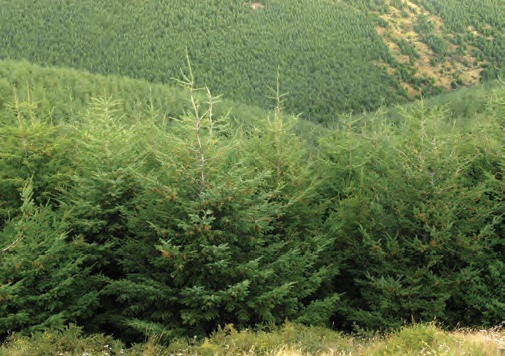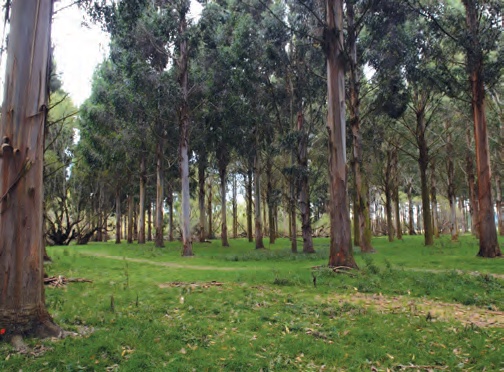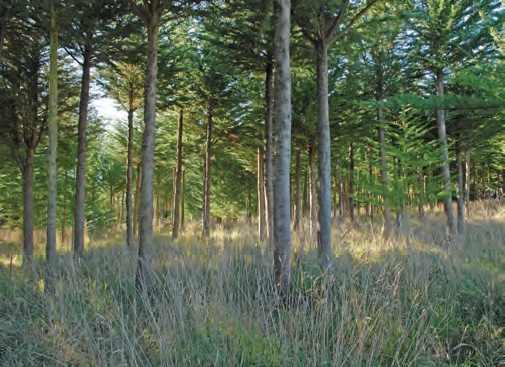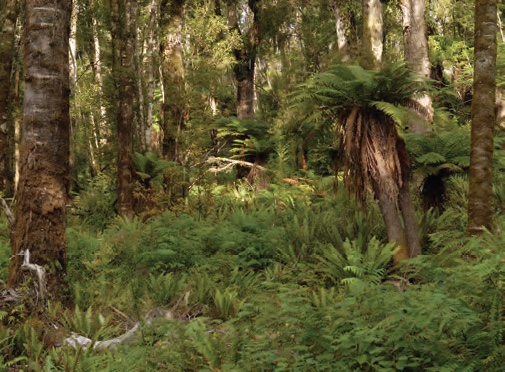Alternative species research five years on
Heidi Dungey, Greg Steward and Patrick Milne, New Zealand Tree Grower November 2014.
The last five years have seen significant progress in assessing the commercial potential of a number of alternative forest tree species. The Diversified Species research programme, one of several in the Future Forests Research portfolio, focussed on making species such as Douglas fir, eucalypts, cypresses, redwoods and some indigenous species viable and proved forestry options. As the primary research provider for the programme, Scion was able to draw on the knowledge and expertise of staff who have had a long association with many of these species, as well as to benefit from a number of peripheral research programmes.
The Diversified Species programme built on research to evaluate species other than radiata pine which dates back to the 1950s. Several MBIE-funded programmes have underpinned this research, for example cypress and indigenous species, as well as the former research cooperatives − the Douglas fir Cooperative, the Stand Management Cooperative and the Eucalypt Cooperative. The programme also built on the extensive body of work already done on indigenous species by Scion researchers Greg Steward and Dave Bergin, while much of the research on coast redwood was contributed by the redwood growing companies. The following article highlights some of the main findings from the past five years.
Douglas fir
Douglas fir, with over 107,000 hectares of planted forests, had the largest research portfolio. The most significant result of this was the contribution from the late Mick Hedley and team into understanding the wettability and moisture retention of Douglas fir.

Douglas fir timber was hard to wet to the point where rot would become a problem at 30 per cent moisture content. While Douglas fir heartwood could not be regarded as equivalent to H1.2 treated radiata pine, it was superior to untreated radiata pine particularly in low to medium risk situations. On the basis of these trials, the Department of Building and Housing released a new treatment regime endorsing untreated Douglas fir for use in framing in specified low risk residential buildings. This was a significant result for the Douglas fir industry and, at the time, contributed to mills remaining operational.
Improved growth
Reaping the benefits of past and current work, improved seed from Douglas fir became available in commercial quantities for the first time. The best seed should produce a genetic gain in growth of at least 30 per cent when compared with traditional seedlots of coastal Washington origin. This equates to an increase in value from $935 to $1,166 a hectare. This is based on an initial 500 index of 28, a site index of 32, a discount rate of eight per cent and a rotation age of 45 years, the standard settings in the Douglas fir calculator.
Assuming this increase in growth rate can achieve a harvestable age at least 20 per cent earlier at age 36, the value from the reduced rotation age alone was estimated to be $2,114, an increase of $948 per hectare. New selections for wood stiffness, and resistance to the needle disease Swiss needle cast in Douglas fir were also made available to commercial seed orchards, and seed from the first high-stiffness material became available. These will begin to be commercially available within seven and 10 years. Seedlots from Oregon proved generally more resistant to Swiss needle cast, and using seed from this provenance in the interim, should improve stand health on warmer sites. Genetic gain trials of New Zealand seed orchard seedlots were planted in 2012.
Silvicultural reviews were also undertaken for Douglas fir. Trials have indicated that over-thinning will cause re-growth of live branches which will reduce the stiffness of the affected stem and the subsequent log grades at harvest. Over-thinning to 250 stems a hectare also slowed stand growth considerably and was detrimental to overall productivity.
Eucalypts
Third generation Eucalyptus nitens seed is now available with improved seed of the other two main eucalypts in the programme, E. fastigata and E. regnans in progress. E. fastigata is showing greatly reduced forking and improved growth and form with seed available from 2014. E. regnans is entering its fourth generation with most trees resistant to the leader dieback and fungal health problems from earlier generations. Current trial stands are looking to set growth records with average heights of six metres after 30 months, and the first seed crop is due in 2016.

All seed stands and orchards of E. fastigata and E. regnans were lost to dairy conversions in recent years. This programme has seen the re-establishment of seed orchards using the latest selections and seed stands using seed collected from best individuals in progeny trials.
Scion researchers are also in the process of developing other eucalypt species specifically for solid wood production, specifically the naturally durable E. muelleriana and E. pilularis. The aim of this programme is to complement the New Zealand Drylands Forest Initiative. Selections from the E. muelleriana trials have already been incorporated into the trials, and the potential for E. pilularis lies in the warmer, wetter areas of the country such as Northland.
Cypress
Approximately 10,400 hectares of cypress are currently planted in New Zealand, the majority on the West Coast of the South Island. Their wood and processing properties make them attractive to end users and growers. Scion’s broader cypress research was given more focus to progress breeding programmes for Cupressus macrocarpa, C. lusitanica, C. guadalupensis, Chamaecyparis nootkatensis and their hybrids. Second generation trials of C. lusitanica and C. macrocarpa were assessed and superior trees selected from the best families. New seed orchards for these cypresses were established, including one with canker-resistant C. macrocarpa, as well as a hybridising orchard which will be used to develop the next generation of cypress hybrid stock.

Existing orchards of C. lusitanica and C. macrocarpa were thinned to improve the seed quality and to phase in new selections. Further research will focus on the development and deployment of new hybrid cypresses, and the development of tree stocks with good wood durability and resistance to canker.
Cypresses need to be pruned to get the best log price, with the aim of producing clear heartwood for panelling, indoor and outdoor furniture and external cladding. Studies have shown that pruning does slow the growth of cypresses, but they catch up again to unpruned trees within a few years.
The durability of cypress heartwood, tested using accelerated fungal cell testing and scanning, was variable. Inner heartwood was found to be less durable than the outer heartwood, and the variation of durability changed with site. Further work into understanding age, site and clone effects will help maximise product quality.
Coast redwood
Durable or semi-durable timber for external use can be produced from coast redwood Sequoia sempervirens. Good growth in New Zealand, along with restrictions on supply from native Californian stands, has increased focus on locally grown crops. Although coast redwood does not yet have a breeding programme, the research was able to bring together many of the commercially available clones for the first time in a series of trials.
The heartwood of coast redwood showed considerable variation, with age appearing to be important. Analysis of density cores from two of the coast redwood Kuser trial series also showed that wood density rankings of clones was consistent. As with cypress, further research will provide a greater understanding of age, site and clone effects on product quality. The redwood durability research is still at an early stage, and we are working with the enthusiastic redwood growing industry to help develop durability screening for use in their redwood programmes.
Indigenous species
A special focus of indigenous species research was on totara and kauri. These two species were chosen as being starting points for the development of planted forests due to the existing knowledge and expertise of Greg Steward and Dave Bergin.

A growth and yield model developed for kauri demonstrated that on good sites, kauri was capable of growing at rates comparable with Douglas fir. Apart from durable heartwood, all the other properties of the wood were remarkably similar to old-growth kauri. Scion has established a stand of totara as a seed source for future planting and a resource for sustainable use.
Establishing indigenous forests is expensive, mainly due to the cost of seedlings raised in containers. However, Scion’s research nursery was able to demonstrate that costs can be reduced by up to half by using bare-root seedlings for several indigenous species. Bare-root transplants also had similar survival and growth rates compared to those grown in containers.
Other projects
The genetics resources programme identified critical stands of contingency species and mapped out a plan to preserve them. Seed stands of provenances of Pinus muricata were planted using seed collected from the best 50 selections in existing seed stands which were about to be harvested. A trial of alternative pine species was planted in areas infected by red needle cast.
New on-line calculators are now available on the Future Forests Research website for E. fastigata, cypresses and kauri. The calculators assess the economic viability of growing these species based on underlying growth models, end-product prices and discount rate assumptions. Net present values and internal rates of return are estimated to help managers make a decision on the economic viability of forest establishment. The results are indicative, but are a good resource for testing different establishment methods, management regimes, and rotation ages. These calculators will be available on the Future Forests Research website until a new website is established.
Overall summary
The Diversified Species programme has significantly advanced knowledge for Douglas fir, cypresses, coast redwood as well as for several eucalypt and indigenous tree species. Future articles will give more detailed information on findings by species.
Gains have included −
- Genetically improved germplasm, improved growth models, calculator development for the evaluation of silvicultural scenarios and information on wood quality to forest growers
- Screening methods for wood durability for redwoods and cypresses
- New knowledge on the potential of kauri and totara in productive planted forests, an improved growth model for kauri, an evaluation of provenance plantings of totara and new plantings established.
The aim is to improve the efficiency and quality of alternative species production, in particular for healthy germplasm and to create new markets and products for many of the species grown in New Zealand. Unfortunately Scion and research partners were unsuccessful in their Ministry of Business, Innovation and Employment bid to extend this work. However, research on these species continues, co-funded by the forest growers’ levy, with a view to re-submitting a proposal this year.
Scion aims to combine forest growing research with some new wood processing technology, such as thermal modification, to reinforce the connection between markets, product performance, species choice and forest management practices. Research at the University of Canterbury, in conjunction with the NZ Drylands Forestry Initiative, is also continuing and they intend to secure future funding.
Heidi Dungey is Science Leader Forest Genetics at Scion and Patrick Milne is a member of the NZFFA Executive.

 Farm Forestry New Zealand
Farm Forestry New Zealand

